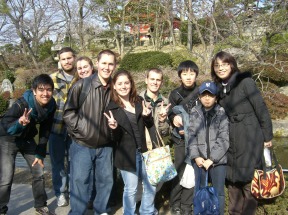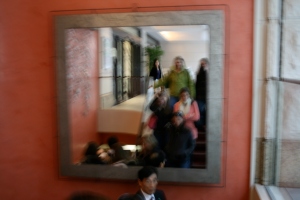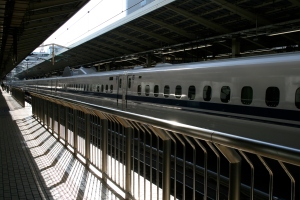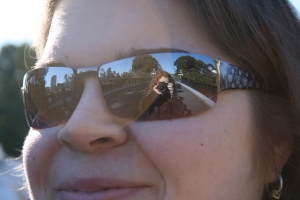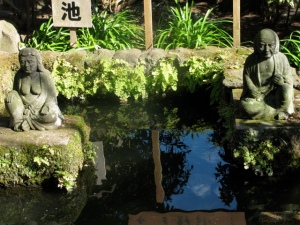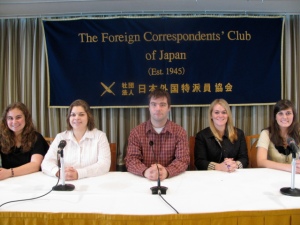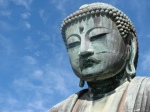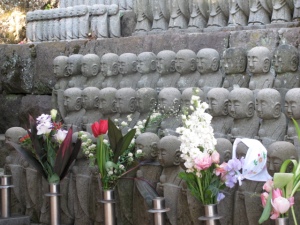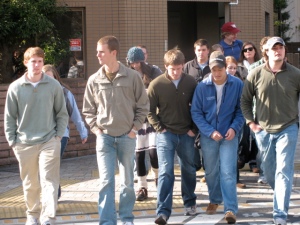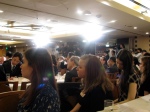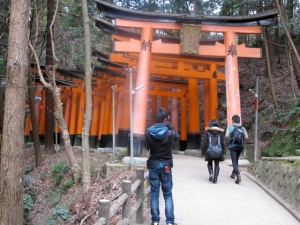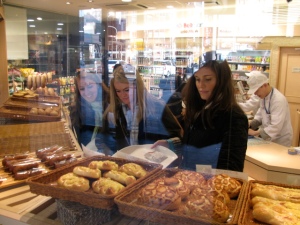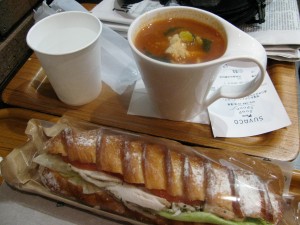2010 in review
The stats helper monkeys at WordPress.com mulled over how this blog did in 2010, and here’s a high level summary of its overall blog health:

The Blog-Health-o-Meter™ reads Wow.
Crunchy numbers
A Boeing 747-400 passenger jet can hold 416 passengers. This blog was viewed about 6,600 times in 2010. That’s about 16 full 747s.
In 2010, there were 24 new posts, growing the total archive of this blog to 136 posts. There were 163 pictures uploaded, taking up a total of 109mb. That’s about 3 pictures per week.
The busiest day of the year was January 11th with 312 views. The most popular post that day was Coming of Age at Kiyomizu-dera.
Where did they come from?
The top referring sites in 2010 were idd.elon.edu, facebook.com, mail.yahoo.com, mail.live.com, and blogs.elon.edu.
Some visitors came searching, mostly for giant jellyfish, miyuki hatoyama, giant jelly fish, yumika araki, and gigantic jellyfish.
Attractions in 2010
These are the posts and pages that got the most views in 2010.
Coming of Age at Kiyomizu-dera January 2010
Giant Echizen Jellyfish and the Fishing Industry November 2009
5 comments
Japan’s first lady wants to change “male-centered society” December 2009
Walking in History with New Friends January 2010
In the Movies: A Set as History and Entertainment January 2010
4 comments
As the Sun Sets Slowly . . .
Every TV travelogue I watched as a kid ended with a cliché like this. The sun was always setting, usually in a “far-off, exotic land,” which included the land of the rising sun. Hmm. We might think of Japan in a travelogue sort of way, but we canjust as properly now think of Japan and its people as closer and more accessible than we once thought. And not quite as different or exotic as we expected, though sometimes driven by different values or customs.
In Japan, people still read newspapers, love baseball, hurry to catch trains and treat one another with impressive respect. They are usually not loud (though there are exceptions) and not late. On average, they walk a lot more than we do and complain less, at least publicly. They know how to help and operate well in large crowds but also taught us how to be silent, even among friends.
We also learned not to rely entirely on generalizations. Our tomodachi, among others, demonstrated that. Everyone is different.
We returned today, a few hours ago. Once through customs, everyone just sort of disappeared, either by filtering out to different (exotic) gates or by pulling luggage out the front door of Dulles International to awaiting family cars. Mina-san, omedeto gozaimashita. Congrats, everyone. And get some more sleep after our 14-hour ride in a passenger jet.
It was a good experience for those who did it with sneakers on the ground in Japan, and, we hope, with imaginations at work back in the States. We hope Japan will always appear to you now as a real place with sincere people and an instructive history. And we hope you will not make this your last visit, nor will this be the end of your curiosity.
We hope your friendships last and that you follow Osamu Suzuki’s advice that what really matters in life and business is building trust.
This was the beginning. Keep after it, scholars. Your research papers should demonstrate your knowledge. Sayonara.
Ashley’s Amazing Art
Ashley Barnas has been recording thousands of photos during our study tour, and this seems like the right moment to display a few. We managed to load some into this laptop so we can share them here. To save time and space, we’ll just give you the photos, without captions. But most of these photos — called ‘art’ in the news world — are so good they don’t need much help from words.
Ashley is a communications major who worked last summer as an intern with The Washington Post, editing video footage. She knows her way around a camera. Several others have been shooting regularly, too, of course. We’re looking at Ashley’s here because she was willing to download a couple of thousand images for us. Can’t wait to check out her Facebook page.
At the End of the Run: Loading Up
We’ll be loading our stuff into the swift Narita Express train, bound for the international airport, tomorrow morning. Until then, I will try to load some more miscellaneous photos onto the blog.
We have of course snapped photos all day on most days. It’s been a bit tricky to load from some cameras into various computers to post them here. But as the day goes on, we’ll see what we can find.
All Ears at Disneyland
We enjoyed the last scheduled event of our study abroad program today when we met Disney’s top executive in Tokyo, Chris Fruean, who spent 90 minutes sharing with us his observations about Tokyo Disneyland.
We met at 5 p.m., which gave students time earlier in the day to sample different activities. About two-thirds of the group went with Dr. Araki to DisneySea, a $4 billion theme park aimed at a post-adolescent market. They emerged later with interesting stories, the latest stuffed bears and quite a range of remarkable head gear, as the photo below reveals. Richard had a good time wearing his new adornment through the subway stations, drawing a few knowing smiles from commuters.
The other group took a good hike through the northern side of the Ginza shopping district and across the adjoining Nihonbashi area to the Tokyo Stock Exchange. Most students were expecting to see the usual chaotic floor scene of active trading we’ve come to imagine about stock markets. But no. Instead, we entered the gallery area to look onto the floor to see a couple of dozen people sitting at stations monitoring electronic screens and large display boards revealing the up-to-the-second status of Japanese stocks. A museum inside the exchange offered an important look into the evolution of the operation over the past 100-plus years.
Another lesson: It’s a digital world now. All of the trades and transactions are handled electronically. Traders apparently don’t need to stake out space inside the exchange any more. The most notable characteristic of the Tokyo exchange was its notable silence; the scene was well-ordered. We should have known. If nothing else, certainly, the digital look reminded us of the power and ubiquity of digital networking. What would happen to the global system — if not the global economy — if the Internet were to go down?
Back to Chris Fruean, Disney’s director for marketing and participant affairs in Tokyo. He described in some detail Disney’s relationship with Oriental Land Company, the firm that actually owns and operates the Disney parks. The Disney people, he said, are there to oversee the brand, to promote sales, and to provide Disney-style methods, or best practices. The Disney folks are obviously highly involved; we could deduce that from his comments. But the relationship is different from the Disney-owned and operated parks in the United States.
He offered a few examples of how situations vary in Japan from the U.S. model. For instance, he noted, the points of entry in popularizing Disney-brand products in America are films that introduce characters, providing a back story. By the time most consumers get to know Aladdin, for instance, they’ve seen the character in a movie. (Pardons to those who caught an earlier misspelling.)
In Japan, though, the point of entry is the park itself. Consumers meet characters there and perhaps buy the goods. “Anything new, if not in the park, it’s not going anywhere (in sales),” he said. Once people meet a new character in the park, though, they are more apt to follow up by going to a film. There are no doubt many causes and effects involved in such practices, and they are worth exploring academically. But since this blog item is long enough already, we’ll stop there. We should note, though, that Mr. Fruean is fluent in Chinese, thanks to his studies and work there earlier in his career. The Disney office in Tokyo, he said, has 10 excellent interpreters.
We should note, though, that tomorrow is our last day. It’s reserved for academic research, final shopping and finding ways to cram everything — including new stuffed Disney characters — into suitcases.
We’ve done a lot, studied some of it, talked too much (in English), made friends more thoroughly, been responsible for more than a few goofs, crooned a few awkward karaoke songs, marveled at the kindness and courtesy implicit in Japanese daily life, and perhaps absorbed some important lessons that will prove even more valuable over time. If we’re lucky, we’ve learned more about ourselves.
Probably a few in the group have even toyed in their minds with the idea of trying to get a job teaching English here some day. Or working for a media company.
We’ll have a lot to think about on the flight home. (A hot bowl of fresh ramen comes to mind.)
In the Spiritual Shadow of History
Every time we venture to see more temples, I think in a too-programmatic way, “Well, maybe we’ve seen enough.” But then every time we find another work of spirit and art that refreshes and prods us to learn a bit more about Japan’s history. Such was the case today in Kamakura, the bayside town that served at the military capital during the dominance of the Minamoto and Hojo clans about 900 years ago.
Our JR train swept through suburbs for almost an hour from Shinagawa to Kamakura. Then we hopped a city bus to reach Kotoku-in temple, where the sitting Buddha waited to inspire us. This is nothing new. The brass statue was cast in 1252. It holds us all yet with its graceful posture.
We hiked nearby to Hase-dera temple take in another impressive statue, this one of Kannon, the Buddhist god/goddess of compassion. This was a 30-foot-high gilded wooden statue carved in 721, long before Minamoto Yoritomo would establish his warrior — later samurai — caste at the Minamoto stronghold of Kamakura around 1185.
Hase-dera, with its pristine gardens, sits on a hillside overlooking the bay. We climbed a trail to gain a sweeping vista of the shoreline, where we could see a cluster of surfers (in wetsuits) waiting on glassy — and perhaps icy — water for some worthy waves. But as a few students noted, on such a nice day, maybe the surfers were content just to bob in the tide and to enjoy any wave that came along. Not a bad sentiment from temple-goers.
Pictures at some Exhibitions
Today’s thrill was our visit to filmmaker Miyazaki Hayao’s Ghibli Museum in Mitaka, a nice suburb west of Tokyo. Miyazaki’s anime has had profound influences on film art as well as the way we think. His films such as Spirited Away and Princess Mononoke offer strong but artful messages to check our human greed and re-embrace nature (before greed ruins us). Other films like My Neighbor Totoro are simply classics of the form.
We couldn’t shoot photos inside the museum, but just as well. That kept our minds more focused on Miyazaki’s superb drawings, films and displays that reveal how animation achieves its sophisticated effects. Displays also provided glimpses of the sources of the artist’s inspiration in the form of hundreds of books with illustrations on creatures, bicycles, plants, sailors, civil wars, aviation, engineering, the Renaissance, architecture, you name it. Isn’t it instructive to realize how often those old-fashioned books still serve the most fundamental purposes.
A short film was too enchanting to end. We wanted more.
Beautifully adorned and balanced with Miyazaki’s signature creations, the museum was superb and more than a little inspirational, especially to students like art major Summer Thaxton, who immediately declared the visit the highlight of her study tour. See a few pictures below of the museum’s clever exteriors.
We had a special visitor today: Tori Davis, a 2009 Elon graduate who is studying on a Fulbright research grant at Tohoku University in Sendai, a regional hub well north of Tokyo. She rolled in early on the shinkansen to join us, a great treat for us. She is studying in three Japanese classes concurrently this semester as well as two other courses in political science — her specialty is international security issues — as she also applies for grad school.
Let me mention another exhibition, this one in the basement of the huge Municipal Metropolitan Building in Tokyo’s Shinjuku district. This had nothing to do with our studies, but it promoted tourism in Fukuoka Prefecture in Kyushu. Some posters were for the hometown of my wife, Misako Matsuishi Scott, and birthplace of our son, Kevin. So pardon the plug, but it was great to come upon references to Kurume.
More to the point for our group, we also took another fast elevator to the municipal building’s 46th floor observatory to scan the spacious Kanto plain, in impressive metro view as far as we could see.
A Look into Making the News

Elon students at lower right join with photographers snapping shots of Osamu Suzuki, president of Suzuki Motor Corp.
We had a great, inside look at the making of news yesterday when we joined in a news conference at the Foreign Correspondents Club of Japan to hear the president of Suzuki Motor Corp. analyze a signifnicant new alliance with Volkswagen.
Osamu Suzuki, the clever and much-respected 79-year-old president and CEO, told a big group of reporters and club members that, even though the deal makes Suzuki in essence part of the world’s largest car-making company, he didn’t think it should change his company’s self-perception. His company, he said, is a small-to-mid-sized organization and should continue to act that way. He spoke of Volkswagen as a mentor as much as a partner and sought to avoid depictions of his company as a world leader.
His 15,000 workers build and sell small, inexpensive cars, so they would have to sell five times the total to consider themselves on par with Toyota, he said. While he thinks the new alliance with Volkswagen might carry the company forward, he wants his company to remain humble. “We should not over-reach beyond our capacity,” he said. “But, on the other hand, we should not be too hesitant.”
Thanks to the generosity of some friends and club officials — especially Shiro Yoneyama, an associate editor of the World News Section for Kyodo News — we had amazing access to the talk, as well as a steak lunch in the club’s professional, 20th-floor facility in Tokyo’s financial and media district. We watched reporters from major news organizations query Suzuki about the alliance, and the moderator even gave our group a chance to ask the president a question.
Nick Friederich stepped up with an excellent question: Noting that Volkswagen already has a successful presence in Brazil, he asked if Suzuki would aim for that emerging market. Suzuki commended his question, a nice gesture, and answered that yes, he would be interested in Brazil if he could learn from “mentor” Volkswagen. He already had noted that Suzuki’s main thrust is now in Asia, and he figured that Volkswagen was interested in the alliance to gain insight into the Asian market as well. Though both companies will share in research and parts, they will build and sell their own cars.
We gained much from this experience, including another big reminder of the value of being not only bilingual but culturally appropriate, a point that Professor Yumika Araki emphasized. We saw many media reporters — Japanese and foreign — in action, and a few approached to offer advice and encouragement. We also had a fine glimpse of one of Japan’s most important businessmen, not to mention a great lunch, and we rubbed elbows with the professional media crowd for a couple of hours.
The people there were remarkably friendly and warm. President Suzuki even paused to wave at our group as he left the room. Wayne Hunter, the club’s acting general manager, invited us back next year, a nice indication of how our students carried themselves. Assistant Manager Chung Hyon Suk also provided great help and support.
The conference offered students a test. For sure they had to concentrate as they processed some fairly technical information. The speech and the Q&A extended for an intense hour-and-a-half, a reminder that successful professionals learn how to listen and concentrate. Today, we’re going to review the stories that emerged on the web from the news conference. Here are links to stories from The Japan Times, the Associated Press and Dow Jones/Wall Street Journal. Browse the web, and you can find more.

Osamu Suzuki turns 80 in a week but told the crowd that he feels more like 56 and wants to continue until he is 100. "I'm in the prime of life, and I most now seriously begin to work," he said. He impressed us with his command of information and his perfect pitch in handling tough questions from reporters.
Every Form of Fish at Tsukiji Fish Market
We’ve explored the narrow corridors of the Tsukiji Fish Market a couple of times this week in smaller groups because too many of us at once would be intrusive. The market is fascinating with its covered grid of fish sellers, the buzz of delivery jitneys, the stacks of Styrofoam storage boxes and, of course, all kinds of fish split, sawed, cleaned, laid out or packed in ice.
This is the largest fish market in the world, and there we were, dodging deliveries and gawking at the tubs of creatures formerly found in the ocean. If this is one day’s haul collected at one land-based location, just how many fish are left swimming in the seas? Enough, I hope, to keep feeding us.
The market does some feeding. Adjoining the actual selling stalls are the sushi shops where fish and rice combine into something special, evident by the line-up of local folks waiting for their sushi breakfast.
We must have snapped about one picture per fish in the market, which may have been more than we needed. But for most of us, this was likely a last chance to scout out the world of marine merchandizing.
What’s it like for the legions of people who work in the dank but surprisingly fresh-smelling stalls of fish-selling every morning? We saw great faces and patient people. We noted their tolerance for us. And we found lots of smiling, joking workers at what must have been the end of another work day as they packed their remaining fish for shuttle trips to various fish retailers. It was morning for us, but perhaps not for them.
Tomorrow, when we’re no longer there, lurking and clicking cameras, they will be back again with new boatloads to slice and sell, and with a few more curious foreigners scattered among them.
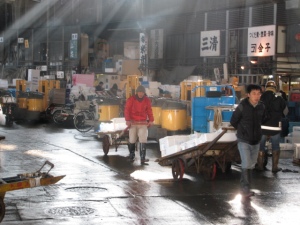
Rubber boots rule: The market had a damp and cozy look all its own much in contrast to the gleaming ultra-new architecture only a block or so from this place.
Shaping Up in Shinjuku
We’ve been out exploring lately and walking lots. This course can only get us all in better shape. Today, we saw the NHK TV studio, hall and offices in the Harajuku-Yoyogi district of Tokyo and then moved to nearby Shinjuku to scout out the huge office towers and artful shops in the district.
We paused for an intentional look inside the seven-floor Kinokuniya bookstore to do a bit of comparative study to consider both quantitative and qualitative ways the store differs from, say, a Barnes & Noble in the center of a major metropolitan area. We found lots of differences. The one that jumped out at students most was fact that they don’t sell coffee in the bookstore.
Related to that, students noticed that the book browsing activity was more of a solo act at Kinokuniya, not as social as at a B&N or some other place. Why? That’s always what we want to consider, and we worked tonight on several explanations. Let’s hope this drives our student scholars into their own favorite bookstores and libraries to dig deeper for answers.
Of course, this was just one store, so we can’t generalize about all Japanese book stores. Dr. Araki reminds us that she knows some that do offer more in the way of entertainment.What’s fascinating about Kinokuniya is its scale, which includes a whole floor of foreign-language books, mostly in English. Many shelves were packed with texts and workbooks devoted to language learning — not something we tend to notice in American stores.
As one student noted, the place was full of people but seemed quiet, without the varied background sounds we’re accustomed to in an American bookstore. About the only audible voices were those of the suitably polite cashiers. Or students making wow sounds after noticing the cost of an American magazine. Note to author: Buy your copies of The Atlantic before crossing the Pacific.
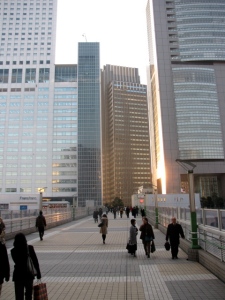
All shades of shiny: We admired the immense office buildings of Tokyo's Shinjuku district. That small shop at bottom right is, believe it or not, a Krispy Kreme store.

At Kinokuniya, the posters on a window promoted books about Michael Jackson and Al Gore, among others.
Fuji-san Comes into View
The night view out of my hotel room window wasn’t much (see post below), but the clear January morning brought something more impressive: a nice shot of Mount Fuji. Such vistas are more common in winter than other seasons because the air is cleaner. It’s even said the likelihood is higher on a weekend because of less emissions.
If Fuji-san stands alone, we placed ourselves in the midst of many today with a visit to the Shinto shrine at Asakusa. The famous pathway leading to the shrine was just packed with people — even more crowded than the photos below suggest. A later visit to the electronics stores in Akhihabara reminded us that life in Tokyo is indeed often packed in public places — and this is a society that knows well how to behave in crowds.

On a clear morning, Fuji-san looms above the Tokyo cityscape. This was shoot from a hotel window after zooming in with my Canon Power Shot. It doesn't appear quite so large from naked eye. Ditto for the buildings.

Our group at the lantern marking the start of the pathway to the temple in Asakusa. Looks like we're the only ones there. Not so. This just shows how well other people can politely stay out of the camera's line of sight.

Elon grads (and sisters) Asami and Keiko Sudani met us at the lantern and guided us on the temple walk. Asami is on far left. Keiko is second from right.

Another view of the Sunday turnout. Perhaps our most compelling lesson today was the realization that in Japan, huge numbers of people can jostle and bump and move this closely without an evident problem. The area for prayers was the most crowded of all. Could we do this so peacefully in the United States? Who wants to write the comparative essay?
Smoothly Easing into Tokyo
If it’s Saturday, this must be Shinagawa.
Our travel day was on time and uneventful — the way we always hope to move the mighty E-30 through Japan — as we rode in spacious shinkansen car No. 12 from Kyoto to Tokyo. Is there any comparison between sitting in a cramped, anchovy can of a passenger jet or a lounge-like shinkansen car?
Not any. We have a bunch of tall guys on this trip, and I think I heard every one of them savoring the leg room offered in bullet-train seats. That was right before they fell asleep after last night’s class karaoke performances, a requisite cultural experience in Japan. Music wizard Stefan Dimuzio, who lives in Tokyo, helped arrange the event and showed classmates how to do things the right way.
It’s not carry-okie around here. Try car-ah-oh-kay.
The E-30 is liking Japan about now. Parents, don’t be surprised if your daughters and sons start mentioning that, after graduation, it might not be the worst thing to, um, spend a year or two teaching English in, say, Nagoya or Kyoto or some other affluent cultural center. And you know how much they enjoy English grammar . . .
This is the fun little twist of irony when we expose students to Japan. They sign up to teach in Japan because they want to spend more time experiencing this well-run and fascinating society. And along the way they finally get serious about syntax.
I forgot to pull out the camera today. Should have chronicled the slumbering lions on the train. So below is a less-than-mediocre effort, a shot from a 16th floor window at our hotel, the Shinagawa Prince. This hotel has a bowling alley, a food court, an indoor driving range, an internet cafe and about 900 people milling around in its three towers and countless restaurants. It’s also directly across the street from a spacious new train terminal building.
Just wish it had a big, quiet library. If it does, we haven’t found it yet. But we will. Tomorrow morning, students are going out in teams to explore the busy area and return with information to share on useful facts like locations of ATMs, post offices (so they can mail another seven post cards) and subway stations. It all helps.

A look out the window -- and off the window-- into nighttime Tokyo. We're on the 16th floor. Some classmates say they have a nice view of Tokyo Tower, the answer here to the Eiffel Tower. No such luck with this photographer. But if Mt. Fuji comes into view, which is possible during the clear, clean-air days of January, we'll post a shot of it here.
Above and Below
Today was our slow-down day. We wrote short papers, packed bags, and prepared to roll out of Kyoto in the morning to reach Tokyo.
But most of us had at least one more location in mind for a final experience here. Following are a few shots of the Fushimi Inari shrine. You’ll no doubt recognize the rows of torii gates below as the same as in the banner photo at the top of the blog. If you saw Memoirs of a Geisha, you may recall a scene in which Chiyo runs through the gates.
To step into the rows of wooden torii is to begin a spiritual journey. The gates extend high into the hillside behind the shrine, so visitors can take the journey as far as needed.
Bread & Breakfast
Across the street from The New Miyako, where we’re staying, await about a dozen bakeries, called panya, that delight us at every turn. And I do mean turn. Every time we return from one of our outings, snaking through the maze of corridors in the Kyoto train station, a new panya seems to come into view, or at least one we didn’t notice earlier.
Suffice to say that, with all of the walking and climbing we’re doing, a little carbo-loading isn’t such a bad thing.
The bakeries vary from our everyday stop at Mister Donut, with its light and balanced pastries (in contrast to some of the famous-franchise sugar bombs back home) to more intentionally French-styled stops. I’ve been trying to sample as many shops as possible. It is a worthy pursuit, even if I’m not going to succeed.
